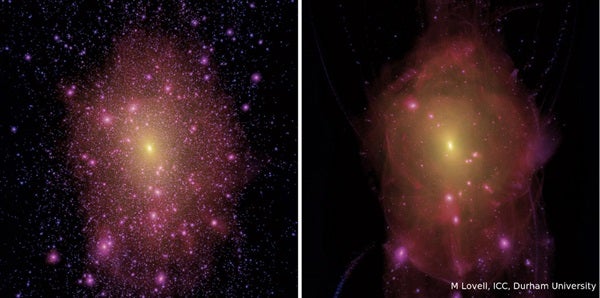The most popular candidate for the elusive particles that give the universe extra mass is cold dark matter (CDM). CDM particles are thought to move slowly compared to the speed of light and interact weakly with electromagnetic radiation. However, no one has managed to detect CDM to date. Sownak Bose from Durham University’s Institute for Computational Cosmology (ICC) will present new predictions at NAM 2015 for a different candidate for dark matter, the sterile neutrino, which may have been detected recently.
“The neutrinos are sterile in that they interact even more weakly than ordinary neutrinos; their predominant interaction is via gravity,” explained Bose. “The key difference with CDM is that just after the Big Bang, sterile neutrinos would have had comparatively larger velocities than CDM and would thus have been able to move in random directions away from where they were born. Structures in the sterile neutrino model are smeared out, compared to CDM, and the abundance of structures on small scales is reduced. By modeling how the universe has evolved from that starting point and looking at the distribution of present-day structures, such as dwarf-mass galaxies, we can test which model — sterile neutrinos or CDM — fits best with observations.”
Last year, two independent groups detected an unexplained emission line at X-ray wavelengths in clusters of galaxies using the Chandra and XMM-Newton X-ray telescopes. The energy of the line fits with predictions for the energies at which sterile neutrinos would decay over the lifetime of the universe. Bose and colleagues from the ICC in Durham are using sophisticated models of galaxy formation to investigate whether sterile neutrino corresponding to such a signal could help zero-in on the true identity of dark matter.
“Our models show that a sterile neutrino with a mass corresponding to the signal detected would also be able to pass many current astrophysical tests of dark matter,” said Bose. “We may have seen the first evidence for sterile neutrinos, and this would be hugely exciting.”
However, not everyone believes that extra mass from dark matter is needed to explain observations. Indranil Banik and colleagues at the University of St. Andrews believe that a modified theory of gravity may be the answer. They have constructed a detailed model predicting velocities of galaxies in the Local Group, which is dominated by the mass of our Milky Way and the neighboring Andromeda Galaxy.
“On large scales, our universe is expanding — galaxies further away are going away from us faster. But on local scales, the picture is more confusing,” said Banik. “We found that running our model in the context of Newtonian gravity did not match the observations very well. Some Local Group galaxies are traveling outwards so fast that it’s as if the Milky Way and Andromeda are exerting no gravitational pull at all!”
The St. Andrews group suggests that these fast-moving outliers could be explained by a gravitational boost from a close encounter between the Milky Way and Andromeda about 9 billion years ago. The fast motions of the two galaxies as they flew past each other, at around 370 miles (600 kilometers) per second, would have caused gravitational slingshot effects on other galaxies in the Local Group.
“This is like the trick spacecraft use to build up speed to reach the outer planets in our solar system. Essentially, the big object — in this case the Milky Way or Andromeda — is slowed down slightly by the gravity from a passing object — the dwarf galaxy — which greatly speeds up as it’s much lighter. This fits our observations but not predictions with Newtonian gravity. This is just not strong enough to be compatible with such a close encounter between the Milky Way and Andromeda. Thus, we believe that our work favors a modified gravity theory and adds to a growing body of evidence from observations of galaxies,” said Banik.
The amount of dark energy in the universe is also a matter of debate. The first evidence for dark energy — an energy field causing the expansion of the universe to accelerate — came through measurements of type Ia supernovae, which are used by astronomers as cosmic lighthouses to determine distances. However, there is now increasing evidence that type Ia supernovae are not “standard candles,” and the precise brightness reached by these exploding white dwarf stars depends on the environment in the host galaxy. Now, Heather Campbell and colleagues at the University of Cambridge have used the largest sample of supernovae and host galaxies to date to study the relation between host galaxy and supernova luminosity.
“Understanding the effect of the properties of the host is critical if astronomers are to make the most precise measurements possible of dark energy,” said Campbell. “More massive galaxies tend to have fainter supernovae. If the galaxy properties are not accounted for properly, then the amount of dark energy in the universe is underestimated. This work is crucial for future telescopes and space missions such as LSST and Euclid, which will attempt to make precision measurements of the expansion of the universe.”
“Although cosmology has made great progress in recent years, many questions remain unanswered and indeed many questions unasked,” said Peter Coles. “This meeting is a timely opportunity to look at some of the gaps in our current understanding and some of the ideas that are being put forward for how those gaps might be filled.”










